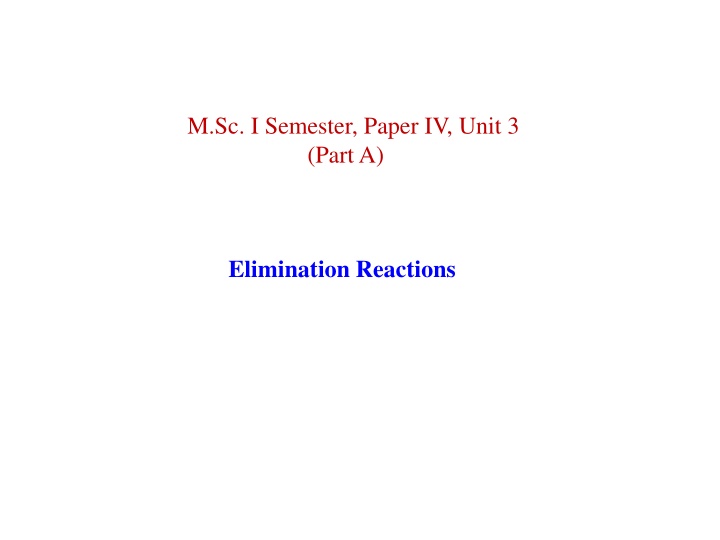
Understanding Elimination Reactions in Organic Chemistry
Explore the mechanisms and principles of elimination reactions in organic chemistry, including E2 and E1 mechanisms, Zaitsev rule, factors affecting reaction rates, and more. Learn about the E2 mechanism's second-order kinetics, regioselectivity, and factors influencing reaction rates.
Download Presentation

Please find below an Image/Link to download the presentation.
The content on the website is provided AS IS for your information and personal use only. It may not be sold, licensed, or shared on other websites without obtaining consent from the author. If you encounter any issues during the download, it is possible that the publisher has removed the file from their server.
You are allowed to download the files provided on this website for personal or commercial use, subject to the condition that they are used lawfully. All files are the property of their respective owners.
The content on the website is provided AS IS for your information and personal use only. It may not be sold, licensed, or shared on other websites without obtaining consent from the author.
E N D
Presentation Transcript
M.Sc. I Semester, Paper IV, Unit 3 (Part A) Elimination Reactions
Elimination Reactions Just as there are two mechanisms of substitution (SN2 and SN1), there are two mechanisms of elimination (E2 and E1). E2 mechanism bimolecular elimination E1 mechanism unimolecular elimination The E2 and E1 mechanisms differ in the timing of bond cleavage and bond formation, analogous to the SN2 and SN1 mechanisms. E2 and SN2 reactions have some features in common, as do E1 and SN1 reactions.
Elimination Reactions Base removes a proton from the -carbon atom, while the halogen atom leaves from the -carbon resulting in the formation of a -bond. Such eliminations are also called -elimination reactions. The Zaitsev (Saytseff) Rule When alkyl halides have two or more different carbons, more than one alkene product is formed.
Elimination Reactions In such cases, the major product is the more stable product the one with the more substituted double bond. This phenomenon is called the Zaitsev rule. The Zaitsev product or the more substituted alkene product is more stable than the less substituted product. The stability of the more substituted alkene is a result of number of different contributing factors, including hyperconjugation. Each alkyl group that can involve in hyperconjugation with the double bond stabilizes it by approximately 6 kcal/mol
The E2 Mechanism The most common mechanism for dehydrohalogenation is the E2 mechanism. It exhibits second-order kinetics, and , both the alkyl halide and the base appear in the rate equation. rate = k[(CH3)3CBr][HO ] The reaction is concerted all bonds are broken and formed in a single step. E2 reactions are regioselective and favor the formation of Zaitsev products.
Factors Affecting the Rate of an E2 Reaction There are close parallels between E2 and SN2 mechanisms in how the identity of the base, the leaving group and the solvent affect the rate. The base appears in the rate equation, so the rate of the E2 reaction increases as the strength of the base increases. E2 reactions are generally run with strong, negatively charged bases like OH and OR . Polar aprotic solvents increase the rate of E2 reactions. There is a partial breaking of the bond to the leaving group in the transition state. So, the better the leaving group the faster the E2 reaction. Rate of reaction follows the order, R I > R Br > R Cl > R F
The SN2 and E2 mechanisms differ in how the R group affects the reaction rate. As the number of R groups on the carbon with the leaving group increases, the rate of the E2 reaction increases. The increase in E2 reaction rate with increasing alkyl substitution can be rationalized in terms of transition state stability. In the transition state, the double bond is partially formed. Thus, the transition state for a more substituted alkene is lower in energy, reducing the activation energy for the reaction and making the reaction faster.
